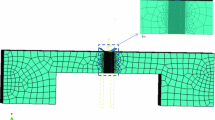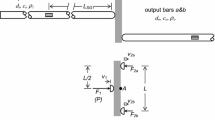Abstract
Previous analysis has shown that the round bend bar is more stable than the rectangular bend beam. The geometry of the round bend bar was slightly modified to permit precracking of ceramic bars for subsequent fracture-toughness testing. Stability solutions of this new modified round bend bar were found as a function of precrack length for several machine-compliance values. A threshold crack length was determined which predicted the transition from unstable to stable fracture behavior. Experiments with silicon nitride and alumina specimens verified the results of the analysis.
Similar content being viewed by others
References
Clausing, D.P., “Crack Stability in Linear Elastic Fracture Mechanics,”Int. J. of Fract. Mech.,5,211–227 (1969).
Underwood, J.H., Baratta, F.I., andZalinka, J.J., “Fracture toughness Tests and Displacement and Crack-stability Analyses of Round Bar Bend Specimens of Liquid-phase Sintered Tungsten,”Experimental Mechanics,31,353–359 (1991).
Baratta, F.I. andDunlay, W.A., “Crack Stability in Simply Supported Four-Point and Three-Point Loaded Beams of Brittle Materials,”Mech. of Mat.,10,149–159 (1990).
Nose, T. andFujii, T., “Evaluation of Fracture Toughness for Ceramic Materials by a Single-Edge-Precracked-Beam Method,”J. Amer. Cer. Soc.,71,328–333 (1988).
Bluhm, J.I., “Stability Consideration in the Generalized Three Dimensional ‘Work of Fracture’ Specimen,”Fracture 1977,3,ICF4, Waterloo, Canada,409–417 (1977).
Baratta, F.I., “Load-Point Compliance of a Three-Point Loaded Cracked-Notched Beam,”J. Test. and Eval.,16,59–71 (1988).
Srawley, J.E., “Wide Range Stress Intensity Factor Expression for ASTM E-399 Standard Fracture Toughness Specimens,”Int. J. Fract.,12,475–476 (1976).
Underwood, J.H. andWoodward, R.L., “Wide Range Stress-intensity-factor Expression for an Edge-cracked Round Bar Bend Specimen,”Experimental Mechanics,29,166–168 (1989).
Cho, K., Hantz, B.F., IV, andBar-On, I., “Stress Intensity Factor Calculation for a Modified Round Bend Bar by 3-D Finite Element Analysis,”Int. J. Fract.,62,163–170 (1993).
Baratta, F.I., “Stability Revisited for a Straight-Fronted Edge Crack in a Three-Point Loaded Round Bend Bar,”Int. J. Fract.,62,R29-R35 (1993).
Quinn, G.D., Corbin, N.D., andMcCauley, J.W., “Thermomechanical Properties of Aluminum Oxynitride Spinel,”Amer. Cer. Soc. Bull.,63 (5),723–729 (1994).
Miller, D.G., Anderson, C.A., Singhal, S.C., Lange, F.F., Diaz, E.S., and Kossowsky, R., “Brittle Materials Design, High Temperature Gas Turbine Material Technology,” AMMRC CTR 76-32,IV,Final Report, (Dec. 1976).
Bratton, R.J. andMiller, D.G., in Ceramics for High Performance Applications—II, ed. J.J. Burke, E.N. Lenoe, andR.N. Katz, Brook Hill Publishing Co., Chestnut Hill, MA (1978).
Lange, F.F., andIskoe, J.L., in Ceramics for High-Performance Applications, ed. J.J. Burke, A.E. Gorum, andR.N. Katz, Brook Hill Publishing Co., Chestnut Hill, MA (1974).
Kossowsky, R., in Ceramics for High-Performance Applications, ed. J.J. Burke, A.E. Gorum, andR.N. Katz, Brook Hill Publishing Co., Chestnut Hill, MA (1974).
Baratta, F.I., Driscoll, G.W., andKatz, R.N., in Ceramics for High-Performance Applications, ed. J.J. Burke, A.E. Gorum, andR.N. Katz, Brook Hill Publishing Co., Chestnut Hill, MA (1974).
Ritter, J., Nair, S., Gennari, P., andDunlay, W., “High-Strength Reaction-Bonded Silicon Nitride,”Adv. Cer. Mat.,3 (4),415–417 (1988).
Bar-On, I., Baratta, F.I., and Cho, K., “Crack Stability and its Effects on Fracture Toughness of Hot Pressed Silicon Nitride Beam Specimen,” to be published in J. Amer. Cer. Soc.
Quinn, G.D., Salem, J., Bar-On, I., Cho, K., Foley, M., andFang, H., “Fracture Toughness of Advanced Ceramics at Room Temperature,”J. Res. Natl. Inst. Stand. Tech.,97,579–607 (1992).
Author information
Authors and Affiliations
Rights and permissions
About this article
Cite this article
Cho, K., Bar-On, I. Crack-stability analysis and fracture toughness of ceramic bend bars with a modified circular cross section. Experimental Mechanics 35, 104–111 (1995). https://doi.org/10.1007/BF02326467
Received:
Revised:
Issue Date:
DOI: https://doi.org/10.1007/BF02326467




